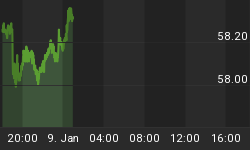Economists have bought into the transitory soft patch thesis of the Fed, hook line and sinker. Please consider Economists' Forecast: Here We Grow Again.
Forecasters in the latest Wall Street Journal survey estimated the U.S. economy contracted at a 0.3% pace in the first quarter because of hits from winter weather and the West Coast port slowdown. But the panel, on average, sees annualized economic growth of 2.8% in the second quarter, supported by stronger job gains and wage growth.
The survey of 62 economists, not all of whom answered every question, showed a widespread expectation that consumers would start spending again after several months of avoiding the mall. The May survey was conducted before the Commerce Department reported retail sales were flat in April, but some economists played down the number.
"The April spending numbers will look better once we get information on services," said Stuart Hoffman of PNC Financial Services. "That's where consumers are spending their money, and the April increase in restaurant sales points to greater demand for services overall."
On average, nonfarm payrolls are expected to rise by 223,000 per month for the final three quarters of 2015, better than the 184,000 pace of the first quarter. The unemployment rate is forecast to fall to 5.1% by the end of this year from 5.4% in April.
Gregory Daco of Oxford Economics said the worst of the pain may have already occurred, especially since energy companies reacted quickly to cheap oil by cutting payrolls and capital-spending plans. "While trade and energy will still have an impact, the drag will be less in the second half," he said.
"Solid job growth and low energy prices could stir spending," said Michael Moran of Daiwa Capital Markets.
Pathetic Performance
Here is an amusing chart of the Fed's own pathetic performance:

from "Honey I Shrunk the Kids"
The date of that post is November 14, 2014. Pay particular attention to that green 2015 line.
Here is the evolution of the Atlanta Fed "GDPNow" first quarter GDP Forecast as of April 2, 2015.
GDPNow Estimate for 1st Quarter - April 2, 2015

The Atlanta Fed at least has a model that makes adjustments. It is not the official Fed forecast.
Next consider a chart from my May 14 post Second Quarter GDP Forecast: Blue Chip vs. GDPNow; Where Might the Fed be Wrong?.
GDPNow vs. Blue Chip

Why the Awful Predictions?
Inquiring minds may be asking "Why Are Economists' Predictions So Damn Awful?"
I was discussing this just yesterday with a small group that shares thoughts every day.
My friend "BC" commented ... "The parasitic 'money-for-nothing' accumulation of money-inflation-induced financial 'wealth' is now a huge net cost to productive economic activity and the capacity of society to sustain its standard of living. Few eCONomists can frame the situation in this way because they are beholding to Wall Street and the top 0.001-1% owners of the rentier-socialist corporate-state at the expense of the middle class".
Pater Tenebrarum at the Acting Man blog replied ... "I totally hate how they have managed to buy off economists. There was time when economists were a thorn in the side of the ruling classes. Previously, the profession required one to tell impolitic truths. Today's economists are spokesmen for the most viciously statist ideology and have essentially become servants of the beast, paid far above their market value for the propaganda services they render."
Self-Preservation Bias
I have commented on this before as well. Investment firms typically get paid on investments, not counting cash. The way to get people invested in something is to be 100% bullish, 100% of the time.
Moreover, you never get fired for being too bullish. Heaven forbid you miss a big rally even if it is as speculative as the dot-com boom in 1999 or the housing boom in 2006.
Explaining the Bias
- The Fed as no vested interest in spooking anyone
- Home builders and realtors always say "now is a good time to buy a home"
- The sell side investment houses always come up with reasons to buy stocks.
- No one ever gets fired for being too bullish
As a self-preservation mechanism, economists are trained to be bullish. A good example of a trade bias is the National Association of Home Builders' Housing Market Index.
In spite of consistently poor traffic for years, home builders have maintained very strong expectations of future home sales.
Recent Economist Misses
- May 15: Consumer Confidence Plunges Below Any Economist's Estimate; Consumers Shock Economists
- May 15: Empire State Manufacturing Weaker Than Economists' Expectations
- May 15: Industrial Production, Down 5th Month, Weaker Than Economist Expectations
- May 14: Producer Prices, Import/Export Prices Decline Again; Still Think the Fed Will Hike?
- May 13: Dismal Retail Sales Numbers Suggest Recession Likely Underway
- May 12: Household Spending Growth Expectations Plunge; Recession Already Started?
Economists have been very wrong for at least five months. And in general, they have been far too optimistic for years.
It all adds up to perpetual economic overoptimistic bias with subsequent downgrades.
Recession Odds

In spite of the fact first quarter GDP is highly likely to be negative, economists believe there is only a 1.2% chance the US is in recession.
Whether or not you think a recession is likely or not, 1.2% is totally absurd.
















